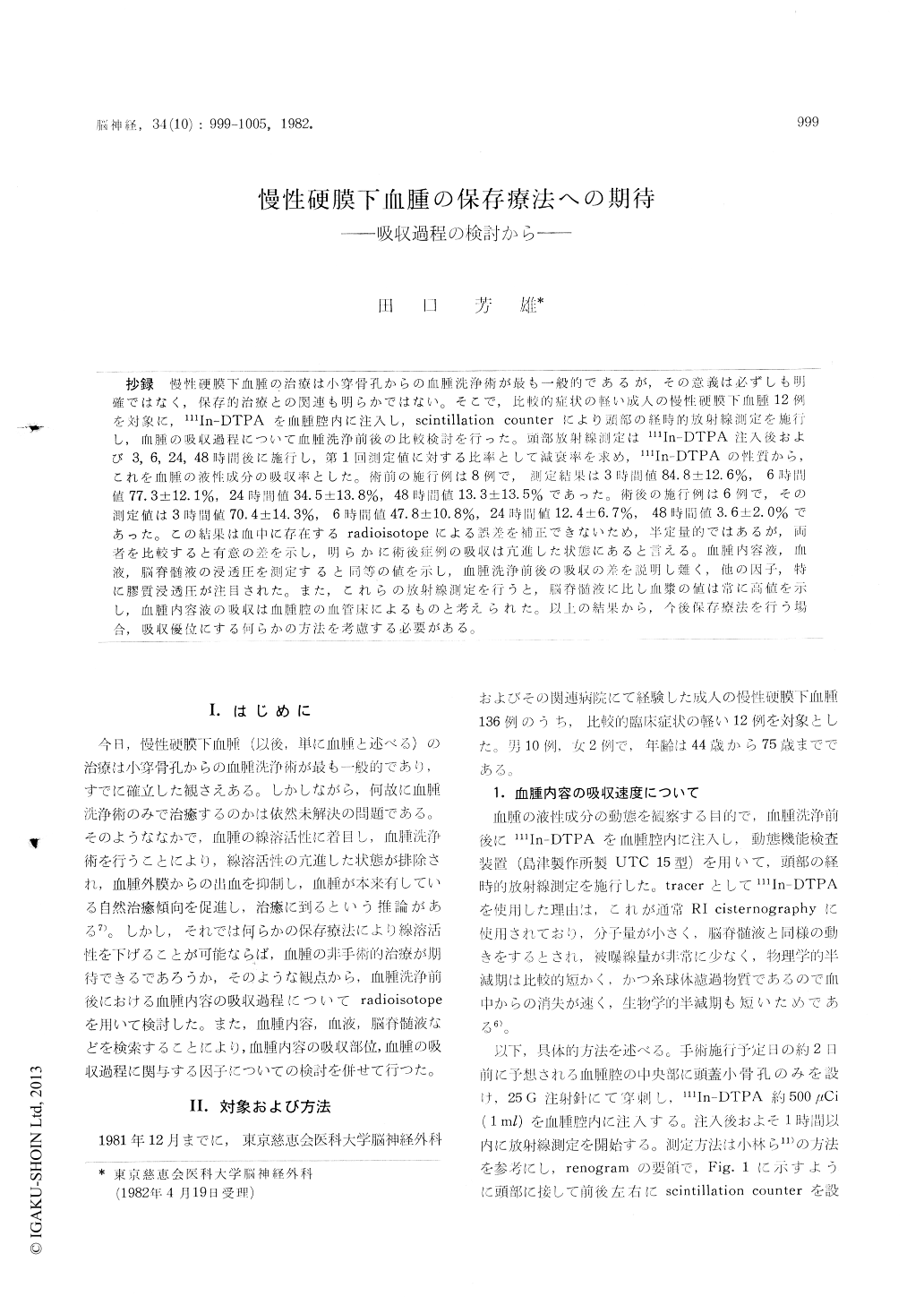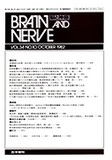Japanese
English
- 有料閲覧
- Abstract 文献概要
- 1ページ目 Look Inside
抄録 慢性硬膜下血腫の治療は小穿骨孔からの血腫洗浄術が最も一般的であるが,その意義は必ずしも明確ではなく,保存的治療との関連も明らかではない。そこで,比較的症状の軽い成人の慢性硬膜下血腫12例を対象に,111In-DTPAを血腫腔内に注入し,scintillation counterにより頭部の経時的放射線測定を施行し,血腫の吸収過程について血腫洗浄前後の比較検討を行った。頭部放射線測定は111In-DTPA注入後および3,6,24,48時間後に施行し,第1回測定値に対する比率として減衰率を求め,111In-DTPAの性質から,これを血腫の液性成分の吸収率とした。術前の施行例は8例で,測定結果は3時間値84.8±12.6%,6時間値77.3±12.1%,24時間値34.5±13.8%,48時間値13.3±13.5%であった。術後の施行例は6例で,その測定値は3時間値70.4±14.3%,6時間値47.8±10.8%,24時間値12.4±6.7%,48時間値3.6±2.0%であった。この結果は血中に存在するradioisotopeによる誤差を補正できないため,半定量的ではあるが,両者を比較すると有意の差を示し,明らかに術後症例の吸収は亢進した状態にあると言える。血腫内容液,血液,脳脊髄液の浸透圧を測定すると同等の値を示し,血腫洗浄前後の吸収の差を説明し難く,他の因子,特に膠質浸透圧が注目された。また,これらの放射線測定を行うと,脳脊髄液に比し血漿の値は常に高値を示し,血腫内容液の吸収は血腫腔の血管床によるものと考えられた。以上の結果から,今後保存療法を行う場合,吸収優位にする何らかの方法を考慮する必要がある。
The most common treatment of chronic sub-dural hematomas is evacuation and irrigation via burr holes. The theory is that chronic subdural hematomas will undergo a natural healing process if such surgery is performed. However, there is no information concerning the course of hematoma absorption. In this work, 111In-DTPA was inje-cted into the hematoma cavity before and after hematoma evacuation and irrigation in 12 cases of chronic subdural hematoma with comparatively mild symptoms. The radioactivity in the head was measure with time using a scintillation counter and the attenuation rate was obtained. The values measured hourly were expressed as ratios of the 1st measured value. Because of the properties of 111In-DTPA, this attenuation rate was considered to be the absorption rate of the liquid components of the hematoma.
In 8 of the preoperative cases, the average measured values, were 84.8±12.6% after 3 hours, 77. 3±12. 1% after six hours, 34. 5±13. 8% after 24 hours and 13. 3±13. 5% after 48 hours. In six of the postoperative cases, the values were 70.4±14. 3% after 3 hours, 47. 8±10. 8% after 6 hours, 12.4±6.7% after 24 hours and 3.6±2.0% after 48 hours.
In a comparison between the two, the post-operative cases showed clearly advanced absorption with a significant difference at a risk factor of 0.1% or less in each case. This is because the osmotic pressure is the same for the liquid in the hematoma, the blood and the cerebrospinal fluid and an explanation based on this alone is difficult ; it is necessary to consider colloid osmotic pressure. When the radioactivities in the liquid in the hematoma, blood and cerebrospinal fluid were measured, the values for the blood were always higher than those for the cerebrospinal fluid and most of the absorption of the hematoma is consi-dered to originate in the vascular bed in the hematoma cavity (sinusoidal channel layer). There-fore, for the conservative treatment of chronic subdural hematomas, it is necessary to consider methods which promote absorption of the hema-toma.

Copyright © 1982, Igaku-Shoin Ltd. All rights reserved.


